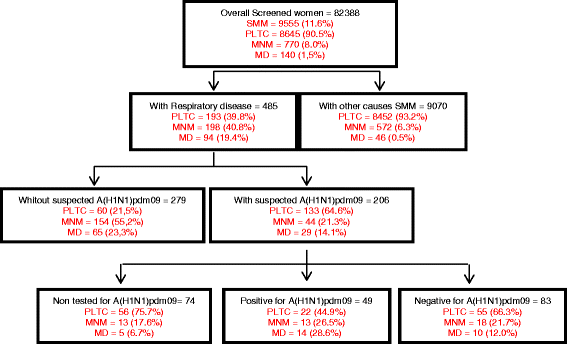Severe maternal morbidity due to respiratory disease and impact of 2009 H1N1 influenza A pandemic in Brazil: results from a national multicenter cross-sectional study
- PMID: 27207244
- PMCID: PMC4894555
- DOI: 10.1186/s12879-016-1525-z
Severe maternal morbidity due to respiratory disease and impact of 2009 H1N1 influenza A pandemic in Brazil: results from a national multicenter cross-sectional study
Abstract
Background: The aim of this study was to assess the burden of respiratory disease, considering the influenza A pandemic season (H1N1pdm09), within the Brazilian Network for Surveillance of Severe Maternal Morbidity, and factors associated with worse maternal outcome.
Methods: A multicenter cross-sectional study, involving 27 referral maternity hospitals in five Brazilian regions. Cases were identified in a prospective surveillance by using the WHO standardized criteria for potentially life-threatening conditions (PLTC) and maternal near miss (MNM). Women with severe complications from respiratory disease identified as suspected or confirmed cases of H1N1 influenza or respiratory failure were compared to those with other causes of severe morbidity. A review of suspected H1N1 influenza cases classified women as non-tested, tested positive and tested negative, comparing their outcomes. Factors associated with severe maternal outcome (SMO = MNM + MD) were assessed in both groups, in comparison to PLTC, using PR and 95 % CI adjusted for design effect of cluster sampling.
Results: Among 9555 cases of severe maternal morbidity, 485 (5 %) had respiratory disease. Respiratory disease occurred in one-quarter of MNM cases and two-thirds of MD. H1N1 virus was suspected in 206 cases with respiratory illness. Around 60 % of these women were tested, yielding 49 confirmed cases. Confirmed H1N1 influenza cases had worse adverse outcomes (MNM:MD ratio < 1 (0.9:1), compared to 12:1 in cases due to other causes), and a mortality index > 50 %, in comparison to 7.4 % in other causes of severe maternal morbidity. Delay in medical care was associated with SMO in all cases considered, with a two-fold increased risk among respiratory disease patients. Perinatal outcome was worse in cases complicated by respiratory disease, with increased prematurity, stillbirth, low birth weight and Apgar score < 7.
Conclusions: Respiratory disease, especially considering the influenza season, is a very severe cause of maternal near miss and death. Increased awareness about this condition, preventive vaccination during pregnancy, early diagnosis and treatment are required to improve maternal health.
Keywords: H1N1; Maternal morbidity; Maternal mortality; Maternal near miss; Respiratory disease.
Figures


References
-
- United Nation 2008 . The Millennium Development Goals report 2008. New York: United Nations Department of Economic and Social Affairs; 2008.
-
- WHO . Targets and strategies for ending preventable maternal mortality: consensus statement. Geneva: World Health Organization; 2014.
-
- World Health Organization . Trends in maternal mortality: 1990 to 2013. Geneva: World Health Organization; 2014.
Publication types
MeSH terms
LinkOut - more resources
Full Text Sources
Other Literature Sources
Medical
Research Materials
Miscellaneous

